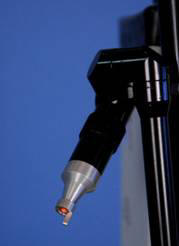During the last fifteen years the application of LASER energy has gained an important role in surgery. The term LASER represents the initials of “Light Amplification by Stimulated Emission of Radiation”. Laser is a special beam of light radiation which does not exist in nature and is produced by special equipment. This radiation needs a source of energy (e.g. electrical power) and a natural mean to be produced (crystal, gas etc.). According to the mean which is used, the radiation has its specific characters.


Special quality of the laser beam that makes it proper for application in surgery is that it provides concentrated energy in a steady beam of light which does not diffuse and decline from its course. In a few words, the light beam begins its course from the source and ends in the target having the same diameter and power. The beam can be transduced either through the air like common light, or through optical fibres. The effect of the laser on human tissue has been studied the last years and special kinds of laser according to each application have been developed.
According to the mean of transduction used, the below types of laser are used in surgery:
- Carbon dioxide – CO2, which is the most frequently used
- Laser NdYag, often used in surgery, endoscopic surgery and gastroenterology.
- Argon beam Laser, used in vascular surgery, because of its effect on the haemoglobin of the capillary vessels.
- Laser Excimer used in ophthalmology
- Other types of Laser, mostly with cosmetic applications.
Nowadays, laser applications are multiple and gradually rising. The basic effect of the laser beam on human tissue depends on several factors, among which is the type of tissue, its content in water, haemoglobin, melanin etc., the wave longitude of the radiation and the power of the beam. The various combinations create a wide range of applications that the specialised surgeon in laser technology has to be familiar with, in order to apply this new technology with safety and efficiency.
Surgical laser applications
Surgical laser is used for the treatment of several conditions. CO2 laser is the basic type of laser applied, providing rapid action, bloodless field, minimal scar and excellent healing. It is used in:
- Lesions of the skin and soft tissue.. Nevus (skin malts), Pappilomas, Nail penetration, Cysts, Lipomas etc.
- Surgical diseases of anus and perineum. It includes haemorrhoids, perianal fistulas, pilonidal disease, genital papilloma etc. The procedures are accompanied by rapid recovery and less pain.
- Endoscopic-laparoscopic surgery. They are very special procedures, demanding special knowledge, as well as special equipment. It is used in several procedures, for example in gynaecological procedures for endometriosis. It is also used in endoscopic gastroenterology, urology and pulmonology for the minimal invasive treatment of tumors and strictures.


